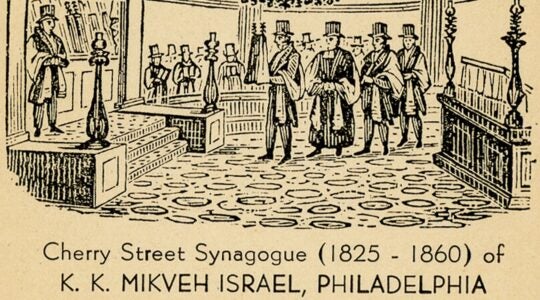(JTA) — “In the United States, ‘Conservative Judaism’ is a synonym for failure.” So writes the Israeli journalist Yair Ettinger after interviewing a spectrum of American Jewish religious leaders. If, as it seems, this judgment has become the new conventional wisdom, we reject it as both inaccurate and destructive.
The rationale for such a gross generalization lies in the decline in numbers of Jews who identify with the Conservative label. In the decades after World War II, and as recently as 1990, the plurality of American Jews self-identified as Conservative. More recently, the Pew Research Center found that by 2013, the Conservative proportion had fallen to 18 percent. That quantitative loss has resulted in a shrinking population of synagogue members, fewer students enrolled in Solomon Schechter day schools — though not in Ramah summer camps — and more limited financial resources for the Conservative movement.
Shorn of any context, these trends seem to point to failure. But a more thoughtful approach might first ask: as compared to what?
True, the declines in Conservative identification are noteworthy relative to surging haredi Orthodox populations and the growing modern Orthodox numbers. But those are standards that no non-Orthodox group has matched. So the more pertinent question is: How do Conservative Jews stack up against the other non-Orthodox populations?
We might begin with “market share.” According to the Pew study, Conservative Jews comprise 20 percent of non-Orthodox Jews 45-59 years old and no less (20 percent) among those aged 30-44. In other words, the Conservative proportion of the non-Orthodox Jewish population is holding steady.
By comparison, 47 percent of non-Orthodox Jews 45-59 identify as Reform, but among their counterparts 30-44, the Reform share drops to 30 percent (with the no-denomination Jews picking up the slack).
What’s more, Conservative Jews have higher birthrates than Reform and non-denominationally identified Jews. Their intermarriage rate is far lower than for other non-Orthodox Jews. For those marrying since 2000, 39 percent of Conservative-raised Jews married non-Jews, as compared to roughly 80 percent for those raised as Reform or nondenominational. Conservative Jews are far more likely to enroll their children in more intensive forms of Jewish schooling and summer camping than other non-Orthodox Jews.
Among members of Conservative and Reform synagogues, large gaps open between them when they are asked about their attachment to Israel, attendance at Shabbat services, involvement with Jewish organizations and the importance of being Jewish in their lives. On all of these and other measures of Jewish involvement, Conservative congregants are far more engaged than their Reform counterparts.
The positive effects of a Conservative Jewish upbringing are most dramatically evident in the 30-44 category. In comparing Conservative-raised with Reform-raised individuals in this age group, we find that the former are far more likely to fast on Yom Kippur; twice as likely to belong to a synagogue and to feel that being Jewish is very important to them; three times as likely to send their children to day school; four times as likely to light Shabbat candles usually; and five times as likely to maintain what they regard as a kosher home.
Why, then, all the damning talk about failure? As the movement in the center, Conservative Judaism has taken fire from groups to its right and to its left since its founding.
Today, some in the centrist Orthodox world are campaigning to stamp out more open-minded approaches to modern Orthodoxy and find it convenient to belittle their foes either as crypto-Conservative Jews or as going down the same “failed” path as the Conservative movement. To the left, it has long been convenient to create the illusion that the Jewish population divides into merely two camps — between the Orthodox and everyone else supposedly marching under a so-called religiously “liberal” banner. The dichotomous language of “Orthodox” and “liberal” blurs very real distinctions in Jewish commitments and outcomes among Conservative, Reform and nondenominational Jews.
If we seek to strengthen American Jewish life, it makes no sense to demean and dismiss a movement with a proven track record of producing and retaining more highly engaged Jews than any other in the non-Orthodox world. And if the goal is to rebuild what we term “the Jewish middle” as a necessary step to reinvigorating Jewish life outside of Orthodoxy, bashing Conservative Judaism is self-defeating.
Wouldn’t the more responsible approach for those who profess to care about the vitality of American Jewry be to help the Conservative movement — even to praise it — so that it can continue to produce, mobilize and serve committed Jews?
(Jack Wertheimer is a professor of American Jewish history at the Jewish Theological Seminary. Steven Bayme has been a visiting professor at the Jewish Theological Seminary. Steven M. Cohen is a professor at Hebrew Union College-Jewish Institute of Religion and director of the Berman Jewish Policy Archive at Stanford University.)
JTA has documented Jewish history in real-time for over a century. Keep our journalism strong by joining us in supporting independent, award-winning reporting.





